Abstract
Mobility as a service (MaaS) is proposed to encourage travelers to choose sustainable mobility options and reduce use of individual car. In the future, mobility services based on autonomous vehicles (AVs) are also incorporated into MaaS. The objective of our work is to elaborate the concept of mobile application, aiding the MaaS based on AVs. We applied a system engineering process-oriented approach to determine the information system components, the functions as well as input and output data. Functions of back-end information system operation and front-end interface of application have been identified, as well as the information flows have been modeled. We highlighted the main differences between MaaS and MaaS based on AVs. We found that recording of event-based points and feedback management are regarded as pivot functions in this self-travel service. Our results facilitate the development of smartphone application for the MaaS based on AVs.
1. Introduction
In the mobility as a service (MaaS) concept, cooperation between public and private transport service providers are managed by the MaaS operator. According to the proposed ideal solution, all kinds of mobility services can be ‘accessed’ via a single smartphone application by travelers. Considering the typical existing MaaS services, the following mobility services or modes are involved: public transport (PT), taxi, car/bike-sharing, ridesharing, ride-sourcing, car rental, scooter sharing.
The MaaS based on autonomous vehicles (AVs) is to be envisaged as a more ‘mature’ MaaS service. The automated or autonomous PT (A-PT) service is proposed for large volume passenger transit; the services of shared AVs (SAVs) are proposed for first/last mile supplementary purpose. Since AV is an intelligent machine, information management is essential in entire travel. The travel planning and transfer processes are significantly supported by transport informatics. The mobility service is based on interactions between travelers and smartphone applications. ‘By the support of online smartphone application, travelers arrive at their destination via a low-carbon emission, environment friendly, and priceworthy multimodal travel chain from departure point by themselves.’ It is identified as the goal of the self-travel service of MaaS based on AVs.
The objective of our work is to elaborate the concept of smartphone application for the MaaS based on AVs. Travel related functions are identified regarding the main system components, where the operation of application-related functions is highlighted. Towards the back-end information system analysis, information flow (input and output data groups) of functions regarding each travel phases, e.g., before, during, and after travel, are presented. In addition, the front-end interface functions of application are introduced and compared with the benchmarking ‘Whim (https://whimapp.com/)’ application. The correspondences between the back and front -end functions have been modeled too.
Two premises are pre-defined as follows:
- The services of SAVs are grouped into two categories: vehicle sharing and vehicle-seat sharing. Small or medium sized vehicles are applied. The former one is similar as the car-sharing service and the later one as the small group ride-sharing service; namely, the A-PT works as the large volume vehicle-seat sharing transit. Reservation based or on-demand service types are not distinguished in our work. In addition, parking issues of vehicles are also not considered.
- The role of public or private MaaS operators is widely discussed in existing publications. In our work, the fleet operator of SAVs is preferred to be the operator of MaaS based on AVs, considering that the most complicated task coordination is managed by this operator.
The A-PT service will still be the schedule and route-based service; however, the management of AV fleet is much more complicated than management of the public transportation. Accordingly, automated operational management is proposed in the MaaS based on AVs system. Most of the real-time data are generated from AV fleets. In the case the operator of PT service belongs to the operator of AV fleets, the data are shared and operated more efficiently. We assume that the main AV fleet operator is appointed to be the operator of this MaaS based on AVs service.
Several smartphone applications for existing MaaS services have been developed by various MaaS operators, but the concept of envisaged mobile application in MaaS based on AVs have not been elaborated. This is identified as the research niche. Accordingly, our research questions are:
- What is the information system architecture?
- What is the back-end operational functions and front-end user interface functions?
- What are the data flows among components and functions?
The multimodal travel chain generation and traveler-vehicle identification are the pivot functions in autonomous mobility. The former one is to balance the demand and supply; the later one is needed for the fare calculation. In addition, feedback management affects the quality of service.
The remainder of the paper is structured as follows. State of the art is summarized in Section 2. Section 3 and Section 4 are to present the back-end operation of application. Section 5 is to introduce the front-end user interface. In Section 3, function groups of travel regarding main system components are determined. The information flow of interacted functions according to the travel chain is modeled in Section 4. In Section 5, the functions on application interface are summarized and new functions are highlighted, the correspondences between front-and back-end functions are modeled. The paper is completed by the concluding remarks in Section 6.
2. State of the Art
The literature is reviewed under topics of MaaS, shared services based on AVs, and mobile application related papers. The structure is shown by Figure 1. Not all reviewed papers contributed to our work directly, however, they have been used as stimulation during our work.
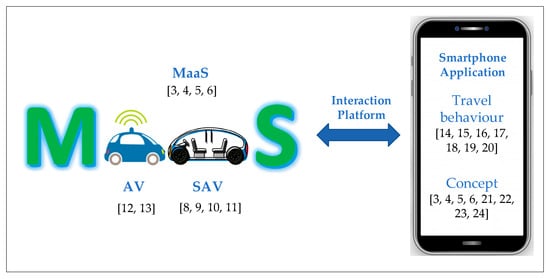
Figure 1.
Structure of literature review.
Transport (or mobility) is already not only an activity to move travelers from point A to B, travelers participate in the travel process more actively and act as a moving information collection and management points. Individuals have their consciousness and requirements [1], this is why transport or mobility should be provided as a service. MaaS is a mobility service which is provided by an integrated transportation system, stakeholders such as MaaS operator, service providers, and users are interacted via a single application [2]. In addition, combined mobility monthly plans are introduced which are available by subscription. Towards MaaS based on AVs, the intelligent vehicles are to be considered as an essential component of the MaaS system, and the simplified service structure requires a new interface to conduct such an interaction.
Several papers mentioned the technology support; namely, the smartphone application is important for MaaS development [2,3,4,5]. Do passengers install the application? Do they operate the application easily? Do they trust the application and believe their privacy to be well protected? These questions are still in discussion and the answers are uncertain. Driven by the development of technology, the AVs are to be incorporated into MaaS [6,7]. Several applications exist to fulfill the MaaS requirements; however, what are the available functions on the application of MaaS based on AVs? This kind of concept is still missing in existing research.
The literature about services of shared autonomous vehicles (SAVs) is summarized in a comprehensive review paper [8], regarding aspects of (1) Traffic and Safety, (2) Travel behavior, (3) Economy, (4) Transport supply, (5) Land use, (6) Environment, (7) Governance. An SAV typology is proposed and concluded that the deployment of AVs may be as shared autonomous mobility services. The integration of SAVs with public transport is widely studied [9,10,11]. A deep case study was presented considering the transportation organization structure of Singapore, where the public transport authority was assumed as the highest organizational unit incorporating with SAV services [9]. SAV services are expected, however, for several individuals, the feeling of vehicle ownership is still important [12]. SAV services are recommended as the first mile commuting supplementary approach incorporated with the PT service [11,13].
Since smartphones are widely used and highly depended on by individuals in daily life [14], MaaS is introduced as a smartphone application-based mobility service. The journey planning, booking, ticketing, and payment functions are available for travelers via application. The collected mobility application related publications are grouped into two categories. Several papers focus on travel behavior analysis as the consequence of information provision [15,16,17,18,19], e.g., how the usage of mobility application influence the travel behavior. Customized and personalized functions, as well as dynamic information, and feedback opportunities are emphasized regarding the concept of mobility application [14]. Customized functions require input of users’ preferences manually. By contrast, personalized functions apply artificial intelligence; users’ preferences are set automatically, considering collected, analyzed behavior and habit data. Besides, gamification is also proposed to be embedded when considering how to attract travelers to be more willing to use mobility application [15,20]. For example, bonus with stars or grades can be applied, which is then converted to a small amount of money.
Another category is about the information management of various mobility services, e.g., the concept of smartphone application regarding services of personalized parking [21], airport [22], electromobility [23], and AV based demand-responsive transport [24]. The relevant system architecture and operational functions are modelled with detailed input and output data groups. The specific additional functions of services are developed in detail. Questionnaire surveys regarding user expectation have been conducted in [21,22], in order to elaborate on user-centric smartphone application. The function of charging spot reservation is introduced with calculation equation in [23]. A concept of smartphone application is elaborated comparing several existing applications, where the new functions based on AVs are highlighted [24].
The research problem, methodology, and main findings of reviewed papers are summarized in Table 1. The key points supported in our work are highlighted with a grey background.

Table 1.
Summary of reviewed papers.
To conclude from the literature, a concept of smartphone application for the MaaS based on AVs is identified as a research niche. Accordingly, we model and elaborate this concept from the operator’s point of view (back-end information management), and the travelers’ point of view (front-end interface functions).
3. Information System Architecture and Functions
A mobile application is supported by the back-end information system and the front-end user interface; namely, user request from the interface is accomplished by the solution provision from information system operation. The integrated mobility services are provided by complex systems, e.g., traffic control and network, management of infrastructure and service; all are interconnected with each other. Since we focus on the information management and the smartphone application, several other sub-systems or system components are not discussed in detail. Accordingly, the following main system components are considered:
T: traveler with smartphone acts as the end-user of mobile application.
M: MaaS operator based on AVs. The information system and mobile application are operated by M.
To: transport service operators or providers. Other service operators are involved as well, e.g., intelligent infrastructure operator, such as smart stop operator; additional data source operator; the food and drink e-sale platform operator. We focus on the information management tasks of transport service operators.
AV: autonomous vehicles; they are regarded as the intelligent machines running on the road.
A large number of data are generated in a connected transportation environment. The available online big data resource is coming from various sensor devices installed on vehicles and infrastructures, from the remote sensing systems that monitor and supervise the transportation network, from the social networks or smartphones of travelers, as well as from the electronic cash flow transactions in mobility services [25]. The characteristics of big data are to be met in the MaaS based on AVs: volume, variety, velocity, veracity, and value [26]. Although several challenges, like the collection, quality, reliability, soundness, storage, security of data still exist, such amounts of data can be handled using the scalable and online cloud services. For example, data analytics methods are supported by various advanced algorithms: e.g., artificial neural networks algorithm, deep learning algorithm, times series algorithms [27]. As well, the data fusion technology is proposed to fuse data from multiple sensors and human-machine interfaces, to improve the quality of collected data and supplement the deep learning process of the system. In addition, autonomous driving is coming in a promising blueprint. The society is optimistic that the AVs could improve traffic safety by reducing the number of collisions due to errors and fatigue made by human drivers [26,27].
To establish the information system architecture for MaaS based on AVs, especially regarding mobile phone application, the system components have been identified first. M acts as the highest third-party organizational role; it is placed between T and To. This mobility service will be managed by cloud-based solution, the operation of mobile application is assigned to M. A vast amount of data is collected and processed by M, in order to reduce the consumption of data transfer and storage among each component. Two major types of services are provided: large volume transit and small group or individual rapid transit. Application interface is used by T; the so called ‘user experience’ is delivered by them. Conventional vehicles without cognitive ability are simply transportation tools in the mobility system, the drivers’ decision and reaction are more relevant; in this sense, conventional vehicles are not really considered as a system component. Involving AVs in the mobility system, AV is identified as a component between T and To. They are available to ‘sense’ the surrounding environment and make decision supported by technologies. AV is an interactive transfer machine; the vehicle itself is considered as one system component. Thus, one stream is ‘T- M- To’, and the other is ‘T -AV- To’, which are placed on the four sides of a rectangle. These four sides of the rectangle are linked by the flow of information.
The back-end information system architecture is modelled, the information function groups of each involved system component (c) and interacted functions between interacted components (ic) are presented in Figure 2.
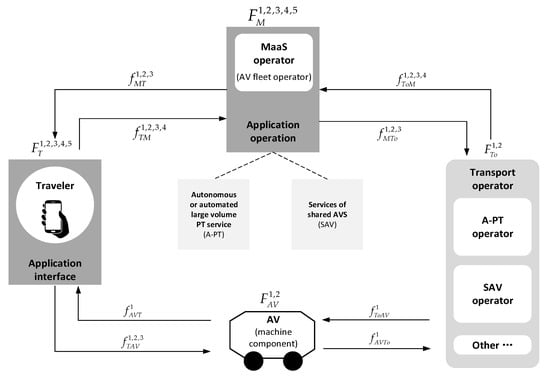
Figure 2.
Information system architecture.
The function groups F are assigned to each component; it shows that the information activity is majorly performed by this component. The interacted functions f are assigned to each two components, which indicates that the detailed information tasks are accomplished by them. The direction is indicated. The back-end subsystem is operated and maintained by the MaaS operator; the data source is open and sharable. The users of the front-end application interface are the travelers.
Five function groups F are determined for T and M, respectively. The significant information interactions are performed by these two components through entire travel. Since AVs are connected into the information system, information exchange between AVs and other components are available for M, two function groups F are determined for AV and To. Interacted functions f are assigned on two ‘circles’, inner circle is identified as ‘‘, the outside circle is identified as ‘‘. Travel request is announced by T and is responded by M accordingly. In order to simplify the indication in the figure, and are not listed individually as and ; instead the combined solution are presented as and .
AVs are not only a transport tool in MaaS anymore; they ‘participate’ in the travel because of its cognitive ability. From a traveler point of view, their travel movement from departure point A to destination point B is involved in the information system, they not only complete their travel but also act as crowdsourcing information collector to optimize the performance of the mobility system. Travelers, together with intelligent vehicles, provide enormous dynamic data to information system in MaaS based on AVs. The system is optimized bidirectionally; a seamless, efficient, and comfortable travel is to be met by travelers.
Pay-as-you-go and monthly mobility plan subscription as fare collection solutions have been introduced in the MaaS. Since travel processes are more advanced and automated in MaaS based on AVs, the ‘recording’ of travel points is significant, e.g., boarding and alighting of each travel leg are essential for the dynamic price accounting in our model. Two types of traveler-vehicle checking are involved: travelers with service of A-PT and SAVs. First case works as ticketless checking, second case is to open and use the vehicle. Bidirectional recognition is recommended.
Dynamic price-based fare collection solution facilitates travelers to pay for ‘what they really used’. Peak and peak-off time travel are to be charged with different prices. A combination of time and distance-based solutions is considered. For example, the time and distance of A-PT use of a traveler is recorded—the travel cost is calculated ‘when’ (peak or peak-off time period) and ‘how far’ (how many bus/metro stops are taken?). For an individual vehicle sharing user, the time usage-based charging is more appropriate, i.e., during which time period and for how long a time is it used?
The information function groups regarding each component are summarized in Table 2.

Table 2.
Function groups of components.
are the function groups in the multimodal travel chain generation process. Travelers announce the travel demand, relevant transport service operators check the available capacity, MaaS operator provide the multimodal travel options. A relevant service is booked by travelers, e.g., vehicle sharing. Demand-capacity is automatedly coordinated and announced by the information system, as every component is connected. Accordingly, the electronic ticket for various modes involved in the travel chain is generated. The travel chain can be interpreted by function groups in the time sequence shown in Figure 3.
Figure 3.
Travel chain regarding function groups in time sequence.
Since the entire travel chain is highly automated, and self-service is available, the entire travel is tracked, but the ‘event’ points are recorded specifically, e.g., boarding/alighting point. The bracket is to present the traveler-vehicle identification, in order to record the boarding process. ‘Communication’ has a different meaning in the environment of connected AVs, information exchange between vehicle and vehicle, vehicle and infrastructure, vehicle and users—such interactions optimize the performance of the mobility system. is introduced to indicate the total cost of travel regarding the calculation and payment process. The fare is automatically calculated; payment is handled by MaaS operator. Feedback and its handling play an essential role in a traveler-centric service. The MaaS based on AVs, is an integrated service of ‘services’ connected in a relatively open information system—involving travelers’ recommendations in service improvement is proposed.
The major information flows of specific travel are to be presented by the interacted functions between the components (in Figure 4). The major involved components (csct) in one specific information task are shown by .
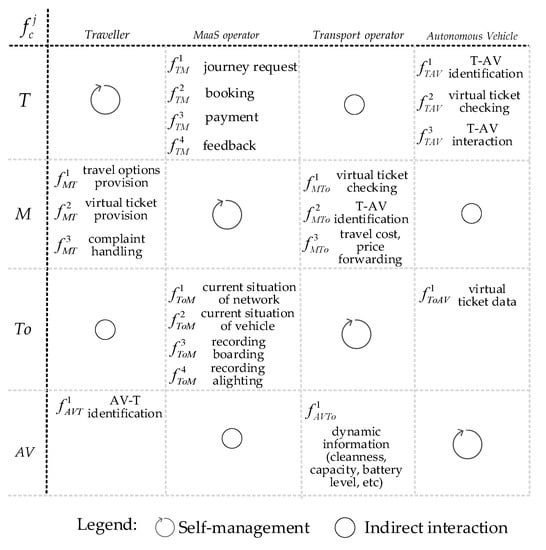
Figure 4.
Interacted functions between components.
Each information component manages their sub-information system. As the M is introduced, the interaction between To and T are eliminated. Vehicle fleet information is managed by the fleet provider. The information is shared with M and M manages the service; the interactions between AV and M are indirect. The information tasks are assigned to each component pairs, in order to improve the efficiency of information sharing and service management.
Furthermore, is addressed in the case that M handles the calculation of total travel cost. The usage of specific modes is recorded by each To; only the most relevant information is forwarded to the M to calculate the total travel cost. In addition, the paid amount is distributed to each To according to these recording data as well.
4. Information Flow
Integrated mobility management or control centers are not involved in system components. On the one hand, MaaS operator handles this role efficiently by coordination of dynamic demand and capacity. On the other hand, MaaS operator is already the highest organizational role. Fewer mobility system components may facilitate the operational efficiency and service quality. Information management is regarded as the backbone of this integrated intelligent mobility service; thus input and output data groups are determined as significant elements of information transfer process. The main data groups are summarized and presented in Table 3.

Table 3.
Data groups of components.
Static data (s) are rarely modified data; they are used to store basic information and the historical data. The historical data are used as the input of travel behavior and habit analysis by the machine system. Monthly or yearly updating is appropriate. Semi-dynamic data (sd) are changeable and event-based data recording. Updating cycle could be hourly or daily. Several dynamic data (d) are collected as ‘tracking data’ and updated every minute, for example, location and communication data, but major dynamic data are event-based—more frequently the update is required, thus belonging to dynamic data, e.g., data of vehicle condition, task coordination.
How do the components interact with each other during travel? What are the information flows between components in a travel process? In order to answer these questions, the input and output data of functions which interact between component pairs are determined and presented according to the travel phases, e.g., phases of before, during, and after travel. We introduce Figure 5 to show one example of a multimodal travel chain indicated with travel phases.
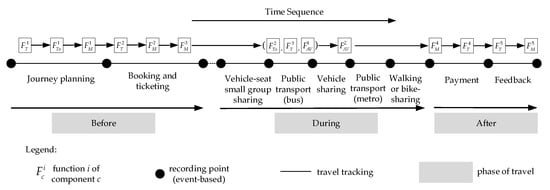
Figure 5.
An example of multimodal travel chain indicating travel phases.
The information flow is generated by the involved functions in the time sequence; input and output data keep the information flow in real-time. The information process of ‘before the travel’ is presented in Figure 6.
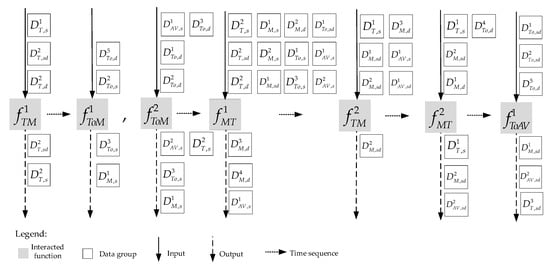
Figure 6.
Information flow of ‘before the travel’ phase.
Travelers announce their travel demand. By applying the information of the updated current situation of network and vehicles, available travel chain options are provided by the MaaS operator. The provision of combination options is the pivot function in ‘before the travel’ phase. In order to provide personalized optimal combination solutions, historical travel data of travelers and their relevant recording, e.g., feedback, the manual input of customized preference setting regarding specific travel, the personalized preference captures, e.g., the automated travel habits analysis results, are the major input data groups. After a traveler selects an option, then booking is confirmed, and virtual ticket or identification code are forwarded to traveler and vehicle.
The information process interpretation of ‘during the travel’ phase is presented in Figure 7.
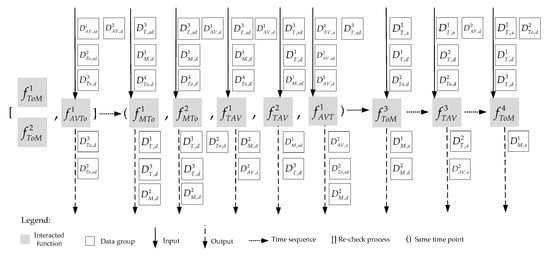
Figure 7.
Information flow of ‘during the travel’ phase.
Before the travel started, the real-time information of transport network and vehicles was updated; in case needed, the travel chain route could be re-planned according to updated data, e.g., in an emergency or disruption situation. The function of the traveler ticket onboard checking or traveler-vehicle (T-AV) identification works actively as driver is eliminated. They are the essential tracking and fare calculation points. After ticket checking or bidirectional identification, the boarding is recorded. During the travel, smartphone application is used by traveler to ‘communicate’ with surrounding connected vehicles, or traveler interacts with vehicle by the touch screen on vehicles. ‘Connected’ AVs have two meaning in this sense, the small vehicle body can connect with each other, or the AVs are connected in information system, information sharing and interaction are available. The latter is considered in our work. Travelers accomplish their travel in a more self-service type by themselves. When the traveler leaves the vehicle, the alighting point is recorded as well.
The information process of ‘after the travel’ phase is presented in Figure 8.
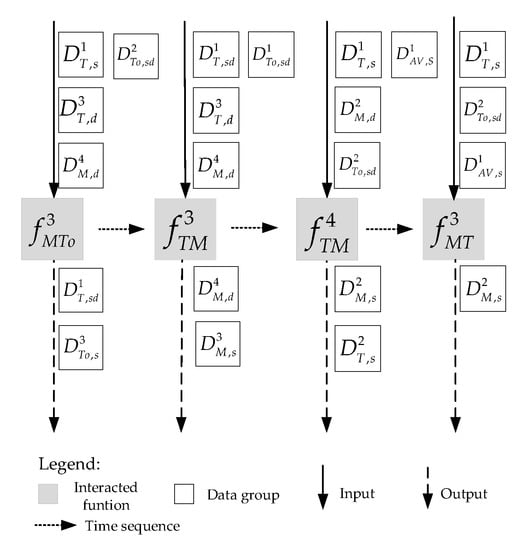
Figure 8.
Information flow of ‘after the travel’ phase.
After the travel, the travel cost calculation, payment, feedback and its handling are general procedures. Dynamic price is available in MaaS based on AVs; travelers pay exactly what they used. For the monthly mobility plan, the approach of MaaS is that MaaS operator provides the mobility plan options, and travelers select one. In the case of MaaS based on AVs, the monthly plan should be tailored for the specific traveler, namely, according to the commuting travelers’ real use, the operator of MaaS based on AVs is responsible to price appropriately for the personalized monthly plan. Instead of providing the stable plans, this operator just calculates the price for the traveler customized choice. For the pay-as-you-go tariff type, the payment process is required after each travel. ‘Traveler management’ is significant in the traveler-centric approach, operator contact with their travelers and build the ‘service loyalty’. Thus, functions of feedback from travelers and its appropriate, efficiency handling enhance the service quality. Operator should really care about travelers’ involvement.
5. Interface Functions of Smartphone Application
The functions of back-end mobile application operation are activated according to functions of interface responded to by travelers. The application interface functions are introduced in this section; the correspondences between back and front -end functions are modelled as well. Interface functions are defined as the functions embedded or displayed on an interface, travelers are available to manage input and receive output of functions, e.g., touch screen to make choice, voice commands, read messages.
The ‘Whim’ is identified as the benchmarking application of MaaS. We introduce the interface functions of application for MaaS based on AVs by comparison with Whim’s. The MaaS Global was established in 2016 in Finland, and accordingly the smartphone application ‘Whim’ was introduced. Together with the Ubigo project of Sweden, Whim and Ubigo are recognized as the first successful MaaS trials [28]. The monthly mobility plan subscription solutions were introduced with the ‘born’ of Whim. The private company MaaS global worked well as the third party MaaS operator; its operational area has been extended to the West Midlands, Antwerp, Vienna, Tokyo, and Singapore. The services of urban PT, taxi, bike/car/e-scooter sharing, car-rental, and train are available to be used with the ‘Whim’ application. Application functions of travel planning, mapping, booking, payment, and ticketing are available. Manually, customization settings are provided, and value-added functions such as saved favorites and service alters are involved as well. Pay-as-you-go and three types of monthly subscription plans are introduced as the tariff structure.
Compared with the ‘Whim’, the smartphone application concept is envisaged and introduced for the MaaS based on AVs regarding the available interface functions in Table 4. Furthermore, indicates basic setting function. In addition, indicate the function i of before/during/after (a/b/c) travel phase.

Table 4.
Functions on interface compared with the benchmarking Whim.
‘Whim’ is already recognized as the top MaaS application and continuously under further implementation [29]. However, compared with the concept of an ‘ideal’ MaaS application, several development aspects and functions are to be introduced. Multimodal options are available with Whim, but ‘seamless’ or ‘one-stop-shop’ service experience is not fully available. For example, if the planned travel chain contains the service of car-sharing, then travelers reserve cars separately. In the most extreme case, if no vehicle is available, the ‘help center’ of Whim recommends that the traveler orders the car-sharing service with an additional company on their own, and ‘Whim’ will equally compensate the cost later with invoice certification (https://helpcenter.whimapp.com/hc/en-us/articles/360024480233-Whim-Weekend#h_f1c592ad-470d-48b1-9132-5ea44e645902). Such a situation often happens at weekends. The separated reservation announcement is needed in the taxi service as well. Moreover, several transitional modes, e.g., ridesharing, ride-sourcing, chauffer service, are not involved because of the inconvenience to manage the private drivers. However, the situation is improved with the service of MaaS based on AVs.
Basic information of vehicles is widely available in existing applications, such as brand, capacity, and pictures of vehicles are shown on the application, but dynamic information of vehicles are not available yet. For example, vehicles of SAV services are major electric vehicles, the real-time data of battery level are both relevant for operator and traveler, the vehicle is charged in advance by operator or during the travel by travelers. Thus, the dynamic battery level information is available in the new application. Along with artificial intelligence-based personalization analysis, travel pattern and habits of travelers are deeply investigated by MaaS operator. Travelers are informed about their travel habits and are possible to shift to a sustainable mobility pattern, e.g., CO2-central mobility with walking and cycling more. Cycling routes and infrastructure are displayed in the new application as well. Several direct supports are recommended for travelers with disabilities, such as voice-embedded GPS guiding to find the vehicle, as special vehicles are not needed for blind people. A traveler-oriented service put the individuals in the center; such a baggage rechecking reminder before alighting is highly proposed. Seat reservation is available in a short distance travel, in order to provide the personalized service.
The connected vehicle environment is expected in the future, functions of information ‘communication’ between connected vehicles and surrounding environments are identified as novel functions, travelers and vehicles are active information components.
For the small group ride-sharing service, opportunities to rate or provide feedback of fellow passengers are necessary, in order to enhance service quality and improve the comfort of individual travel experience. On the assumption that individuals concern travel environment more in the future, such energy and emission report analyses facilitate travelers to turn to more sustainable and green mobility. From the traveler-centric point of view, traveler satisfaction analysis and report function attract travelers to use a service more. The feedback from the operator works as a bidirectional response, not as before, as only travelers provide their feedback. The aim is to attract travelers to ‘wish’ to use the service of MaaS based on AVs, not only because they ‘have to’ choose it as they need to be transported.
The correspondences between back- and front-end functions are modelled with Figure 9.

Figure 9.
Correspondences between front-end and back-end functions in time sequence.
Taking data flows into account, the information flow between back-end and front-end functions are determined in time sequence. The interface functions are available on the application; the functionalities are realized by touching the screen from users’ operation. Travel demand is announced by travelers; input data is generated from several components. On the surface, the travel is guided or initiated at each step by the operation of front-end functions from travelers; facing the truth, the route generation and travel tracking such core functions are accomplished by the operation of back-end functions from MaaS operator. The active response between front- and back-end functions, namely the information flow, guide the traveler to accomplish the self-travel.
Since we discuss and focus on grey background new functions, the identified input and output data groups are assigned to the new functions too, which are summarized in Table 5.

Table 5.
Input and output data groups of new functions.
6. Conclusions
The MaaS is proposed to facilitate the service integration and sustainable mobility. AVs as intelligent machines are incorporated into MaaS, we elaborated the concept ‘MaaS based on AVs’ in our work focusing on mobile application. System engineering top-down and process-oriented approaches were applied. The main system components were determined, and the main function groups of components were introduced. As information management is the backbone of this service, the back-end information flows of application were identified and presented, considering input and output data groups in interacted functions for each travel phase (before, during, after). In addition, the front-end application interface functions were devised considering the existing MaaS application. The correspondences between back and front -end functions were also modelled. We considered both the MaaS operator’s and traveler’s aspects. The main contributions are:
- information system architecture model and identified functions,
- operational and information flow model,
- model of correspondences between back-end and front-end functions.
We have found that:
- as the MaaS based on AVs is a highly automated self-service, recording event-based points is significant for travel fare calculation, e.g., boarding and alighting,
- feedback management is the pivot function. Travel habits and behavior of travelers are more relevant for operator to analysis service performance and user satisfaction,
- new traveler-centric functions are to be developed, e.g., baggage reminder function, fellow passengers rating.
A lesson learnt in this study was that the available literature on our topics is rather limited. Many researchers worked on travel behavior analysis of smartphone application aiding mobility, however, very few works with systematic approaches revealed the information management of the application.
Our further research direction is to extend the topic on gamification inserted into mobile application, in order to investigate the factors affecting the change of travel behavior. Several gamification-oriented mobility approaches exist in either mobile application or real-life practice, and the following research questions have been identified. What are the major influence factors regarding gamification aiding mobility? How do travelers consider points, badges, leadership in gamification embedded application? How can social networks aid gamification in mobility services? An international online questionnaire survey will be conducted, and statistical analysis results will be addressed to answer these questions. The research aim is to support the software development for such gamification-oriented applications, considering the MaaS based on AVs service. MaaS is not only a concept that is relevant for passenger transport, the freight transport is to be incorporated as well. Our other further research direction is to elaborate a parcel delivery service concept embedding in MaaS, based on AVs framework. Taking this Coronavirus-19 epidemiological situation into consideration, contactless delivery may work appropriately, not only in emergency situation, but also in case of one traveler sharing the vehicle space with one ‘the same way’ parcel, applying this traveler-parcel combination transport form to balance empty vehicle redistribution tasks, in order to optimize the resource allocation of society.
Author Contributions
Conceptualization, Y.H. and C.C.; methodology, Y.H. and C.C.; validation, Y.H. and C.C.; writing—original draft preparation, Y.H.; writing—review and editing, Y.H. and C.C.; supervision, C.C. All authors have read and agreed to the published version of the manuscript.
Funding
This research received no external funding.
Acknowledgments
The research reported in this paper was supported by the EFOP-3.6.3-VEKOP-16-2017-00001: Talent management in autonomous vehicle control technologies—The Project is supported by the Hungarian Government and co-financed by the European Social Fund. The research reported in this paper and carried out at the Budapest University of Technology and Economics was supported by the “TKP2020, Institutional Excellence Program” of the National Research Development and Innovation Office in the field of Artificial Intelligence (BME IE-MI-FM TKP2020).
Conflicts of Interest
The authors declare no conflict of interest.
References
- Myrovali, G.; Morfoulaki, M.; Vassilantonakis, B.-M.; Mpoutovinas, A.; Kotoula, K.M. Travelers-led Innovation in Sustainable Urban Mobility Plans. Period. Polytech. Transp. Eng. 2020, 48, 126–132. [Google Scholar] [CrossRef]
- Arias-Molinares, D.; García-Palomares, J.C. The Ws of MaaS: Understanding mobility as a service from a literature review. Iatss Res. 2020. [Google Scholar] [CrossRef]
- Smith, G.; Hensher, D.A. Towards a framework for mobility-as-a-service policies. Transp. Policy 2020, 89, 54–65. [Google Scholar] [CrossRef]
- Alonso-González, M.J.; Hoogendoorn-Lanser, S.; Van Oort, N.; Cats, O.; Hoogendoorn, S. Drivers and barriers in adopting Mobility as a Service (MaaS)-A latent class cluster analysis of attitudes. Transp. Res. Part A Policy Pract. 2020, 132, 378–401. [Google Scholar] [CrossRef]
- Ho, C.Q.; Mulley, C.; Hensher, D.A. Public preferences for mobility as a service: Insights from stated preference surveys. Transp. Res. Part A Policy Pract. 2019, 131, 70–90. [Google Scholar] [CrossRef]
- Wong, Y.Z.; Hensher, D.A.; Mulley, C. Mobility as a service (MaaS): Charting a future context. Transp. Res. Part A Policy Pract. 2020, 131, 5–19. [Google Scholar] [CrossRef]
- Obaid, M.; Szalay, Z. A Novel Model Representation Framework for Cooperative Intelligent Transport Systems. Period. Polytech. Transp. Eng. 2020, 48, 39–44. [Google Scholar] [CrossRef]
- Narayanan, S.; Chaniotakis, E.; Antoniou, C. Shared autonomous vehicle services: A comprehensive review. Transp. Res. Part C Emerg. Technol. 2020, 111, 255–293. [Google Scholar] [CrossRef]
- Shen, Y.; Zhang, H.; Zhao, J. Integrating shared autonomous vehicle in public transportation system: A supply-side simulation of the first-mile service in Singapore. Transp. Res. Part A Policy Pract. 2018, 113, 125–136. [Google Scholar] [CrossRef]
- Levin, M.W.; Odell, M.; Samarasena, S.; Schwartz, A. A linear program for optimal integration of shared autonomous vehicles with public transit. Transp. Res. Part C Emerg. Technol. 2019, 109, 267–288. [Google Scholar] [CrossRef]
- Tian, L.-J.; Sheu, J.-B.; Huang, H.-J. The morning commute problem with endogenous shared autonomous vehicle penetration and parking space constraint. Transp. Res. Part B Methodol. 2019, 123, 258–278. [Google Scholar] [CrossRef]
- Lee, J.; Lee, D.; Park, Y.; Lee, S.; Ha, T. Autonomous vehicles can be shared, but a feeling of ownership is important: Examination of the influential factors for intention to use autonomous vehicles. Transp. Res. Part C Emerg. Technol. 2019, 107, 411–422. [Google Scholar] [CrossRef]
- Wen, J.; Chen, Y.X.; Nassir, N.; Zhao, J. Transit-oriented autonomous vehicle operation with integrated demand-supply interaction. Transp. Res. Part C Emerg. Technol. 2018, 97, 216–234. [Google Scholar] [CrossRef]
- Xu, K. Language, modality, and mobile media use experiences: Social responses to smartphone cues in a task-oriented context. Telemat. Inform. 2020, 48, 101344. [Google Scholar] [CrossRef]
- Andersson, A.; Hiselius, L.W.; Adell, E. Promoting sustainable travel behaviour through the use of smartphone applications: A review and development of a conceptual model. Travel Behav. Soc. 2018, 11, 52–61. [Google Scholar] [CrossRef]
- Zong, W.; Zhang, J. Use of smartphone applications and its impacts on urban life: A survey and random forest analysis in Japan. Sustain. Cities Soc. 2019, 49, 101589. [Google Scholar] [CrossRef]
- Jamal, S.; Habib, M.A. Smartphone and daily travel: How the use of smartphone applications affect travel decisions. Sustain. Cities Soc. 2020, 53, 101939. [Google Scholar] [CrossRef]
- Khan, N.A.; Habib, M.A.; Jamal, S. Effects of smartphone application usage on mobility choices. Transp. Res. Part A Policy Pract. 2020, 132, 932–947. [Google Scholar] [CrossRef]
- Gadziński, J. Perspectives of the use of smartphones in travel behaviour studies: Findings from a literature review and a pilot study. Transp. Res. Part C Emerg. Technol. 2018, 88, 74–86. [Google Scholar] [CrossRef]
- Nakashima, R.; Sato, T.; Maruyama, T. Gamification approach to smartphone-app-based mobility management. Transp. Res. Procedia 2017, 25, 2344–2355. [Google Scholar] [CrossRef]
- Cserháti, B.; Csiszár, C. Conception of a personalized parking assistant application. Period. Polytech. Civ. Eng. 2016, 60, 181–188. [Google Scholar] [CrossRef]
- Karádi, D.; Csiszár, C.; Nagy, E. In Integrated information application on mobile devices for air passengers. In Proceedings of the 2015 International Conference on Models and Technologies for Intelligent Transportation Systems (MT-ITS), Budapest, Hungary, 3–5 June 2015; pp. 304–311. [Google Scholar] [CrossRef]
- Csiszár, C.; Pauer, G. Concept of an integrated mobile application aiding electromobility. Transport 2019, 34, 187–194. [Google Scholar] [CrossRef]
- Szigeti, S.; Csiszár, C.; Földes, D. Information management of demand-responsive mobility service based on autonomous vehicles. Procedia Eng. 2017, 187, 483–491. [Google Scholar] [CrossRef]
- Dimitrakopoulos, G.; Uden, L.; Varlamis, I. Chapter 19-Big data analytics for intelligent transportation systems. In The Future of Intelligent Transport Systems; Dimitrakopoulos, G., Uden, L., Varlamis, I., Eds.; Elsevier: Amsterdam, The Netherlands, 2020; pp. 207–221. ISBN 9780128182819. [Google Scholar] [CrossRef]
- Neilson, A.; Daniel, B.; Tjandra, S. Systematic review of the literature on big data in the transportation domain: Concepts and applications. Big Data Res. 2019, 17, 35–44. [Google Scholar] [CrossRef]
- Kaffash, S.; Nguyen, A.T.; Zhu, J. Big data algorithms and applications in intelligent transportation system: A review and bibliometric analysis. Int. J. Prod. Econ. 2020, 231, 107868. [Google Scholar] [CrossRef]
- Smith, G.; Sochor, J.; Sarasini, S. Mobility as a Service: Comparing developments in Sweden and Finland. Res. Transp. Bus. Manag. 2018, 27, 36–45. [Google Scholar] [CrossRef]
- Sochor, J.; Arby, H.; Karlsson, M.; Sarasini, S. A topological Approach to Mobility as a Service: A Proposed Tool for Understanding Requirements and Effects, and for Aiding the Integration of Societal Goals. In Proceedings of the 1st International Conference on Mobility as a Service (ICOMaaS), Tampere, Finland, 28–29 November 2017. [Google Scholar] [CrossRef]
© 2020 by the authors. Licensee MDPI, Basel, Switzerland. This article is an open access article distributed under the terms and conditions of the Creative Commons Attribution (CC BY) license (http://creativecommons.org/licenses/by/4.0/).